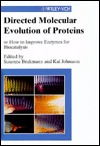Directed Molecular Evolution of Proteins
Natural selection created optimal catalysts. However, optimal performance of enzyme catalysis does not necessarily refer to maximum reaction rate. Rather, it may be a compromise between specificity, rate, stability, and other chemical constraints that makes enzymes capable of catalyzing reactions under mild conditions and with high substrate specificity, accompanied by high regio- and enantioselectivity.\ The book presented here focuses on the directed evolution of proteins, which has...
Search in google:
Natural selection created optimal catalysts. However, optimal performance of enzyme catalysis does not necessarily refer to maximum reaction rate. Rather, it may be a compromise between specificity, rate, stability, and other chemical constraints that makes enzymes capable of catalyzing reactions under mild conditions and with high substrate specificity, accompanied by high regio- and enantioselectivity.The book presented here focuses on the directed evolution of proteins, which has established itself as a powerful method for designing enzymes showing new substrate specificities. It includes a comprehensive repertoire of techniques for producing combinatorial enzyme libraries, while the functional gene expression in a suitable host helps in selecting the appropriate structure, making fast screening a necessity. This book illustrates both the theoretical background as well as the potential of this interesting method in practice - which is becoming ever more important even in classical organic synthesis! Booknews Fourteen chapters provide a snapshot of some of the recent advances in the application of evolutionary and combinatorial techniques in the development of proteins. After outlining the fundamental principles of the field, papers address such topics as the directed evolution of binding proteins by cell surface display, screening strategies of biocatalyst discovery, directed evolution as a means to create enantioselective enzymes for use in organic chemistry, and applied molecular evolution of enzymes involved in synthesis and repair of DNA. Annotation c. Book News, Inc., Portland, OR (booknews.com)
List of ContributorsXI1Introduction12Evolutionary Biotechnology--From Ideas and Concepts to Experiments and Computer Simulations52.1Evolution in vivo--From Natural Selection to Population Genetics52.2Evolution in vitro--From Kinetic Equations to Magic Molecules82.3Evolution in silico--From Neutral Networks to Multi-stable Molecules162.4Sequence Structure Mappings of Proteins252.5Concluding Remarks263Using Evolutionary Strategies to Investigate the Structure and Function of Chorismate Mutases293.1Introduction293.2Selection versus Screening303.2.1Classical solutions to the sorting problem313.2.2Advantages and limitations of selection323.3Genetic Selection of Novel Chorismate Mutases333.3.1The selection system353.3.2Mechanistic studies373.3.2.1Active site residues373.3.2.2Random protein truncation423.3.3Structural studies443.3.3.1Constraints on interhelical loops443.3.4Altering protein topology463.3.4.1New quaternary structures473.3.4.2Stable monomeric mutases493.3.5Augmenting weak enzyme activity513.3.6Protein design533.4Summary and General Perspectives574Construction of Environmental Libraries for Functional Screening of Enzyme Activity634.1Sample Collection and DNA Isolation from Environmental Samples654.2Construction of Environmental Libraries684.3Screening of Environmental Libraries714.4Conclusions765Investigation of Phage Display for the Directed Evolution of Enzymes795.1Introduction795.2The Phage Display795.3Phage Display of Enzymes815.3.1The expression vectors815.3.1.1Filamentous bacteriophages815.3.1.2Other phages835.3.2Phage-enzymes845.4Creating Libraries of Mutants875.5Selection of Phage-enzymes895.5.1Selection for binding895.5.2Selection for catalytic activity905.5.2.1Selection with substrate or product analogues905.5.2.2Selection with transition-state analogues925.5.2.3Selection of reactive active site residues by affinity labeling965.5.2.4Selection with suicide substrates985.5.2.5Selections based directly on substrate transformations1025.6Conclusions1086Directed Evolution of Binding Proteins by Cell Surface Display: Analysis of the Screening Process1116.1Introduction1116.2Library Construction1136.2.1Mutagenesis1136.2.2Expression1146.3Mutant Isolation1156.3.1Differential labeling1156.3.2Screening1196.4Summary124Acknowledgments1248Advanced Screening Strategies for Biocatalyst Discovery1598.1Introduction1598.2Semi-quantitative Screening in Agar-plate Formats1618.3Solution-based Screening in Microplate Formats1648.4Robotics and Automation1699Engineering Protein Evolution1779.1Introduction1779.2Mechanisms of Protein Evolution in Nature1789.2.1Gene duplication1799.2.2Tandem duplication180[beta alpha]-barrels1819.2.3Circular permutation1829.2.4Oligomerization1839.2.5Gene fusion1849.2.6Domain recruitment1849.2.7Exon shuffling1869.3Engineering Genes and Gene Fragments1879.3.1Protein fragmentation1889.3.2Rational swapping of secondary structure elements and domains1899.3.3Combinatorial gene fragment shuffling1909.3.4Modular recombination and protein folding1949.3.5Rational domain assembly--engineering zinc fingers1999.3.6Combinatorial domain recombination--exon shuffling2009.4Gene Fusion--From Bi- to Multifunctional Enzymes2039.4.1End-to-end gene fusions2039.4.2Gene insertions2039.4.3Modular design in multifunctional enzymes2049.5Perspectives20810Exploring the Diversity of Heme Enzymes through Directed Evolution21510.1Introduction21510.2Heme Proteins21610.3Cytochromes P45021810.3.1Introduction21810.3.1Mechanism22010.3.2.1The catalytic cycle22010.3.2.2Uncoupling22210.3.2.3Peroxide shunt pathway22210.4Peroxidases22310.4.1Introduction22310.4.2Mechanism22310.4.2.1Compound I formation22310.4.2.2Oxidative dehydrogenation22610.4.2.3Oxidative halogenation22610.4.2.4Peroxide disproportionation22610.4.2.5Oxygen transfer22710.5Comparison of P450s and Peroxidases22710.6Chloroperoxidase22810.7Mutagenesis Studies22910.7.1P450s23010.7.1.1P450[subscript cam]23010.7.1.2Eukaryotic P450s23010.7.2HRP23110.7.3CPO23110.7.4Myoglobin (Mb)23210.8Directed Evolution of Heme Enzymes23310.8.1P450s23310.8.2Peroxidases23410.8.3CPO23610.8.4Catalase I23610.8.5Myoglobin23710.8.6Methods for recombination of P450s23710.9Conclusions23811Directed Evolution as a Means to Create Enantioselective Enzymes for Use in Organic Chemistry24511.1Introduction24511.2Mutagenesis Methods24711.3Overexpression of Genes and Secretion of Enzymes24811.4High-Throughput Screening Systems for Enantioselectivity25011.5Examples of Directed Evolution of Enantioselective Enzymes25711.5.1Kinetic resolution of a chiral ester catalyzed by mutant lipases25711.5.2Evolution of a lipase for the stereoselective hydrolysis of a meso-compound26811.5.3Kinetic resolution of a chiral ester catalyzed by a mutant esterase26911.5.4Improving the enantioselectivity of a transaminase27011.5.5Inversion of the enantioselectivity of a hydantoinase27011.5.6Evolving aldolases which accept both D- and L-glyceraldehydes27111.6Conclusions27312Applied Molecular Evolution of Enzymes Involved in Synthesis and Repair of DNA28112.1Introduction28112.2Directed Evolution of Enzymes28212.2.1Site-directed mutagenesis28312.2.2Directed evolution28412.2.3Genetic damage28512.2.4PCR mutagenesis28612.2.5DNA shuffling28712.2.6Substitution by oligonucleotides containing random mutations (random mutagenesis)28812.3Directed Evolution of DNA polymerases28912.3.1Random mutagenesis of Thermus aquaticus DNA Pol I29112.3.1.1Determination of structural components for Taq DNA polymerase fidelity29212.3.1.2Directed evolution of a RNA polymerase from Taq DNA polymerase29312.3.1.3Mutability of the Taq polymerase active site29412.3.2Random oligonucleotide mutagenesis of Escherichia coli Pol I29412.4Directed Evolution of Thymidine Kinase29512.5Directed Evolution of Thymidylate Synthase29712.6O[superscript 6]-Alkylguanine-DNA Alkyltransferase30012.7Discussion30213Evolutionary Generation versus Rational Design of Restriction Endonucleases with Novel Specificity30913.1Introduction30913.1.1Biology of restriction/modification systems30913.1.2Biochemical properties of type II restriction endonucleases31013.1.3Applications for type II restriction endonucleases31113.1.4Setting the stage for protein engineering of type II restriction endonucleases31313.2Design of Restriction Endonucleases with New Specificities31313.2.1Rational design31313.2.1.1Attempts to employ rational design to change the specificity of restriction enzymes31314.2.1.1Changing the substrate specificity of type IIs restriction enzymes by domain fusion31613.2.1.3Rational design to extend specificities of type II restriction enzymes31613.2.2Evolutionary design of extended specificities31813.3Summary and Outlook32414Evolutionary Generation of Enzymes with Novel Substrate Specificities32914.1Introduction32914.2General Considerations33114.3Examples33314.3.1Group 133314.3.2Group 233714.3.3Group 333814.4Conclusions339Index343
\ From The CriticsFourteen chapters provide a snapshot of some of the recent advances in the application of evolutionary and combinatorial techniques in the development of proteins. After outlining the fundamental principles of the field, papers address such topics as the directed evolution of binding proteins by cell surface display, screening strategies of biocatalyst discovery, directed evolution as a means to create enantioselective enzymes for use in organic chemistry, and applied molecular evolution of enzymes involved in synthesis and repair of DNA. Annotation c. Book News, Inc., Portland, OR (booknews.com)\ \








